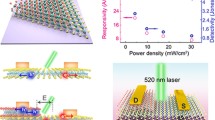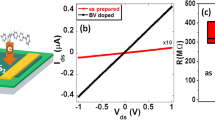Abstract
Two-dimensional (2D) heterostructures based on layered transition metal dichalcogenides (TMDs) have attracted increasing attention for the applications of the next-generation high-performance integrated electronics and optoelectronics. Although various TMD heterostructures have been successfully fabricated, epitaxial growth of such atomically thin metal-semiconductor heterostructures with a clean and sharp interface is still challenging. In addition, photodetectors based on such heterostructures have seldom been studied. Here, we report the synthesis of high-quality vertical NbS2/MoS2 metallic-semiconductor heterostructures. By using NbS2 as the contact electrodes, the field-effect mobility and current on-off ratio of MoS2 can be improved at least 6-fold and two orders of magnitude compared with the conventional Ti/Au contact, respectively. By using NbS2 as contact, the photodetector performance of MoS2 is much improved with higher responsivity and less response time. Such facile synthesis of atomically thin metal-semiconductor heterostructures by a simple chemical vapor deposition strategy and its effectiveness as ultrathin 2D metal contact open the door for the future application of electronics and optoelectronics.
摘要
基于过渡金属硫族化合物的二维材料异质结, 由于其在下一 代高性能集成光电子器件中的潜在应用而备受关注. 虽然目前异 质结制备很广泛, 但是外延生长具有干净锐利界面的原子级别厚 度金属-半导体异质结仍然备受挑战. 另外, 基于金属-半导体异质 结的光电性能还鲜有研究. 这里, 我们报道了高质量垂直金属-半导 体异质结的合成, 其中金属性质的单层NbS2外延生长于单层MoS2 表层. 使用NbS2作为电极接触的MoS2晶体管, 其迁移率和电流开 关比相对于Ti/Au接触的MoS2晶体管分别提升了6倍和2个数量级. 另外, 基于NbS2作为电极接触的MoS2光电探测器, 其响应时间和光 响应可以分别提升至少30倍和20倍. 本工作通过简单的化学气相 沉积(CVD)方法制备的原子级别厚度的金属-半导体异质结和二维 金属材料在接触方面的作用为其在光电子器件中的应用奠定了基 础.
Similar content being viewed by others
References
Gong Y, Yuan H, Wu CL, et al. Spatially controlled doping of two-dimensional SnS2 through intercalation for electronics. Nat Nanotech, 2018, 13: 294–299
Wang C, He Q, Halim U, et al. Monolayer atomic crystal molecular superlattices. Nature, 2018, 555: 231–236
Wang Y, Xiao J, Zhu H, et al. Structural phase transition in monolayer MoTe2 riven by electrostatic doping. Nature, 2017, 550: 487–491
Wang Z, Gibertini M, Dumcenco D, et al. Determining the phase diagram of atomically thin layered antiferromagnet CrCl3. Nat Nanotechnol, 2019, 14: 1116–1122
Liao M, Wu ZW, Du L, et al. Twist angle-dependent conductivities across MoS2/graphene heterojunctions. Nat Commun, 2018, 9: 4068
Zhou X, Hu X, Zhou S, et al. Tunneling diode based on WSe2/SnS2 heterostructure incorporating high detectivity and responsivity. Adv Mater, 2018, 30: 1703286
Xiao Y, Zhang T, Zhou M, et al. Disassembly of 2D vertical heterostructures. Adv Mater, 2019, 31: 1805976
Luo Y, Li X, Cai X, et al. Two-dimensional MoS2 confined Co(OH)2 electrocatalysts for hydrogen evolution in alkaline electrolytes. ACS Nano, 2018, 12: 4565–4573
Zhang D, Du J, Hong YL, et al. A double support layer for facile clean transfer of two-dimensional materials for high-performance electronic and optoelectronic devices. ACS Nano, 2019, 13: 5513–5522
Liu L, Wu J, Wu L, et al. Phase-selective synthesis of 1T’ MoS2 monolayers and heterophase bilayers. Nat Mater, 2018, 17: 1108–1114
Son SB, Kim Y, Kim AR, et al. Ultraviolet wavelength-dependent optoelectronic properties in two-dimensional NbSe2-WSe2 van der Waals heterojunction-based field-effect transistors. ACS Appl Mater Interfaces, 2017, 9: 41537–41545
Yang T, Zheng B, Wang Z, et al. Van der Waals epitaxial growth and optoelectronics of large-scale WSe2/SnS2 vertical bilayer p-n junctions. Nat Commun, 2017, 8: 1906
Lee H, Bak S, An SJ, et al. Highly efficient thin-film transistor via cross-linking of 1T edge functional 2H molybdenum disulfides. ACS Nano, 2017, 11: 12832–12839
Shin HG, Yoon HS, Kim JS, et al. Vertical and in-plane current devices using NbS2/n-MoS2 van der Waals Schottky junction and graphene contact. Nano Lett, 2018, 18: 1937–1945
Gong Y, Lin J, Wang X, et al. Vertical and in-plane heterostructures from WS2/MoS2 monolayers. Nat Mater, 2014, 13: 1135–1142
Hsu WT, Lu LS, Wu PH, et al. Negative circular polarization emissions from WSe2/MoSe2 commensurate heterobilayers. Nat Commun, 2018, 9: 1356
Xue Y, Zhang Y, Liu Y, et al. Scalable production of a few-layer MoS2/WS2 vertical heterojunction array and its application for photodetectors. ACS Nano, 2016, 10: 573–580
Fu Q, Wang X, Zhou J, et al. One-step synthesis of metal/semiconductor heterostructure NbS2/MoS2. Chem Mater, 2018, 30: 4001–4007
Leong WS, Ji Q, Mao N, et al. Synthetic lateral metal-semiconductor heterostructures of transition metal disulfides. J Am Chem Soc, 2018, 140: 12354–12358
Ji Q, Li C, Wang J, et al. Metallic vanadium disulfide nanosheets as a platform material for multifunctional electrode applications. Nano Lett, 2017, 17: 4908–4916
Zhou J, Lin J, Huang X, et al. A library of atomically thin metal chalcogenides. Nature, 2018, 556: 355–359
Suh J, Park TE, Lin DY, et al. Doping against the native propensity of MoS2: Degenerate hole doping by cation substitution. Nano Lett, 2014, 14: 6976–6982
Zhang J, Wu J, Guo H, et al. Unveiling active sites for the hydrogen evolution reaction on monolayer MoS2. Adv Mater, 2017, 29: 1701955
Jeong H, Oh HM, Gokarna A, et al. Integrated freestanding two-dimensional transition metal dichalcogenides. Adv Mater, 2017, 29: 1700308
Zhang Y, Yin L, Chu J, et al. Edge-epitaxial growth of 2D NbS2-WS2 lateral metal-semiconductor heterostructures. Adv Mater, 2018, 30: 1803665
Wang X, Lin J, Zhu Y, et al. Chemical vapor deposition of trigonal prismatic NbS2 monolayers and 3R-polytype few-layers. Nanoscale, 2017, 9: 16607–16611
Han JH, Kim HK, Baek B, et al. Activation of the basal plane in two dimensional transition metal chalcogenide nanostructures. J Am Chem Soc, 2018, 140: 13663–13671
Li Z, Yang W, Losovyj Y, et al. Large-size niobium disulfide nanoflakes down to bilayers grown by sulfurization. Nano Res, 2018, 11: 5978–5988
Jouve G, Séverac C, Cantacuzène S. XPS study of NbN and (NbTi)N superconducting coatings. Thin Solid Films, 1996, 287: 146–153
Gong Y, Liu Z, Lupini AR, et al. Band gap engineering and layer-by-layer mapping of selenium-doped molybdenum disulfide. Nano Lett, 2014, 14: 442–449
Cui X, Kong Z, Gao E, et al. Rolling up transition metal dichalcogenide nanoscrolls via one drop of ethanol. Nat Commun, 2018, 9: 1301
Hong W, Shim GW, Yang SY, et al. Improved electrical contact properties of MoS2-graphene lateral heterostructure. Adv Funct Mater, 2018, 29: 1807550
Wu R, Tao Q, Dang W, et al. Van der Waals epitaxial growth of atomically thin 2D metals on dangling-bond-free WSe2 and WS2. Adv Funct Mater, 2019, 29: 1806611
Li M, Lin CY, Yang SH, et al. High mobilities in layered InSe transistors with indium-encapsulation-induced surface charge doping. Adv Mater, 2018, 30: 1803690
Das S, Chen HY, Penumatcha AV, et al. High performance multilayer MoS2 transistors with scandium contacts. Nano Lett, 2013, 13: 100–105
Abraham M, Mohney SE. Annealed Ag contacts to MoS2 field-effect transistors. J Appl Phys, 2017, 122: 115306
Maurel C, Ajustron F, Péchou R, et al. Electrical behavior of the Au/MoS2 interface studied by light emission induced by scanning tunneling microscopy. Surf Sci, 2006, 600: 442–447
Liu Y, Stradins P, Wei SH. Van der Waals metal-semiconductor junction: Weak Fermi level pinning enables effective tuning of Schottky barrier. Sci Adv, 2016, 2: e1600069
Liu Y, Guo J, Zhu E, et al. Approaching the Schottky-Mott limit in van der Waals metal-semiconductor junctions. Nature, 2018, 557: 696–700
Sun B, Wang Z, Liu Z, et al. Tailoring of silver nanocubes with optimized localized surface plasmon in a gap mode for a flexible MoS2 photodetector. Adv Funct Mater, 2019, 29: 1900541
Zhang W, Huang JK, Chen CH, et al. High-gain phototransistors based on a CVD MoS2 monolayer. Adv Mater, 2013, 25: 3456–3461
Yin Z, Li H, Li H, et al. Single-layer MoS2 phototransistors. ACS Nano, 2012, 6: 74–80
Wang Y, Kim JC, Wu RJ, et al. Van der Waals contacts between three-dimensional metals and two-dimensional semiconductors. Nature, 2019, 568: 70–74
Lopez-Sanchez O, Lembke D, Kayci M, et al. Ultrasensitive photodetectors based on monolayer MoS2. Nat Nanotech, 2013, 8: 497–501
Chang YH, Zhang W, Zhu Y, et al. Monolayer MoSe2 grown by chemical vapor deposition for fast photodetection. ACS Nano, 2014, 8: 8582–8590
Hu PA, Wang L, Yoon M, et al. Highly responsive ultrathin GaS nanosheet photodetectors on rigid and flexible substrates. Nano Lett, 2013, 13: 1649–1654
Zhou Y, Nie Y, Liu Y, et al. Epitaxy and photoresponse of two-dimensional GaSe crystals on flexible transparent mica sheets. ACS Nano, 2014, 8: 1485–1490
Zeng W, Li J, Feng L, et al. Synthesis of large-area atomically thin BiOI crystals with highly sensitive and controllable photodetection. Adv Funct Mater, 2019, 29: 1900129
Zou Z, Li D, Liang J, et al. Epitaxial synthesis of ultrathin β-In2Se3/MoS2 heterostructures with high visible/near-infrared photo-response. Nanoscale, 2020, 12: 6480–6488
Liu H, Li D, Ma C, et al. Van der Waals epitaxial growth of vertically stacked Sb2Te3/MoS2 p-n heterojunctions for high performance optoelectronics. Nano Energy, 2019, 59: 66–74
Acknowledgements
This work was financially supported by the National Key R&D Program of China (2018YFA0306900 and 2018YFA0305800), and the National Natural Science Foundation of China (51872012).
Author information
Authors and Affiliations
Contributions
Gong Y and Zhang P conceived and designed the experiments. Zhang P synthesized the heterojunction; Bian C made the devices and carried out the measurement; Ye J carried out the photodetector measurement; Cheng N carried out the HAADF-STEM experiments. All the authors participated in discussions and approved the manuscript.
Corresponding authors
Additional information
Conflict of interest
The authors declare that they have no conflict of interest.
Supplementary information
Experimental details and supporting data, including the growth process, AFM, optical images, XPS, HAADF-STEM images, electrical properties are available in the online version of the paper.
Peng Zhang received his BS degree (2013) from the Department of Electronic Engineering, Nantong University, Jiangsu, and PhD degree (2018) from the Department of Electronic Engineering, East China Normal University, Shanghai. He is currently working as a postdoctoral fellow in the Department of Materials Science and Engineering, Beihang University, Beijing. His research interests focus on the controlled synthesis of novel low-dimension materials, and the application research of functional devices.
Ce Bian received his BSc degree from Shandong University. He is currently a PhD student at the Institute of Physics, Chinese Academy of Sciences. His research interests involve chemical vapor deposition and device applications of two-dimensional materials and heterostructures.
Jiafu Ye received his BS degree in materials science and engineering from Central South University, Changsha, China, in 2017. He is currently working towards his PhD degree in condensed matter physics at Shanghai Institute of Technical Physics, Chinese Academy of Sciences, under the supervision of Prof. Weida Hu. His current research interests focus on the synthesis and characterizations of novel low-dimensional materials, and their potential applications in electronic and photoelectronic devices.
Lihong Bao received his PhD degree from the Institute of Physics, Chinese Academy of Sciences. Now, he is an associate professor at the Institute of Physics, Chinese Academy of Sciences. His research interests focus on the construction and electronic transport properties of low-dimensional electronic devices.
]Weida Hu received his PhD degree in microelectronics and solid-state electronics from Shanghai Institute of Technology Physics, Chinese Academy of Sciences, in 2007. He is currently a full professor in Shanghai Institute of Technology Physics, Chinese Academy of Sciences. His current research interests focus on the fabrication and characterizations of infrared photoelectronic devices.
Yongji Gong received his BS degree (2011) in chemistry from Peking University and PhD degree (2015) in chemistry from Rice University. Then, he worked as postdoctoral fellow in the Department of Materials Science and Engineering in Stanford University (2016-2017). From 2017, he has been a professor in the Department of Materials Science and Engineering, Beihang University. His scientific interest focuses on the controllable synthesis and propertiy tuning of 2D materials for electronics and energy storage and conversion.
Supplementary Information
40843_2020_1355_MOESM1_ESM.pdf
Epitaxial growth of metal-semiconductor van der Waals heterostructures NbS2/MoS2 with enhanced performance of transistors and photodetectors
Rights and permissions
About this article
Cite this article
Zhang, P., Bian, C., Ye, J. et al. Epitaxial growth of metal-semiconductor van der Waals heterostructures NbS2/MoS2 with enhanced performance of transistors and photodetectors. Sci. China Mater. 63, 1548–1559 (2020). https://doi.org/10.1007/s40843-020-1355-2
Received:
Accepted:
Published:
Issue Date:
DOI: https://doi.org/10.1007/s40843-020-1355-2




